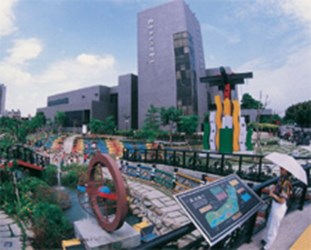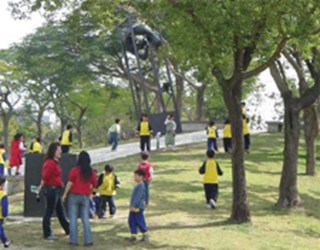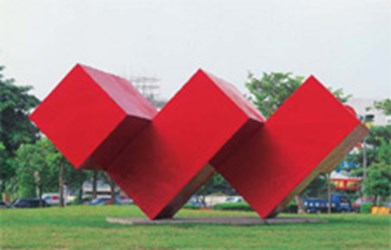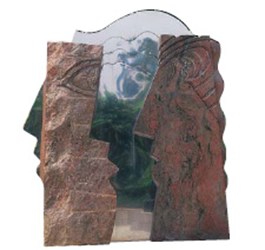Words and pictures by Yang Jing-Wen
Translated by Cara Steenstra
You too can become an art connoisseur by paying a visit to the country's one and only art museum, where works of master artists will capture your eyes with their unique sculptural pieces.
The National Taiwan Museum of Fine Arts occupies a large area, with an undulating landscape of hills and water, where green pastures compliment blue skies and white clouds, thus attracting a lot of visitors from Central Taiwan with its lovely surroundings. Some people come here to enjoy the museum exhibits, thereby adding a bit of artistic elegance to their personal aura. Many schools and groups come here for outdoor activities, and you will see children running and jumping about, casting their happy shadows on the green pastures. Around dusk each day, health conscious citizens gather here for their daily exercise routines, some dance, some practice Tai Chi, others take a walk along the healthy footpath. No matter what your reason might be for coming to visit the museum, you will surely not miss out on admiring the many sculptures of different sizes and shapes placed around the area. This is not something you can easily find else where in Taiwan.
Exquisite Artwork From the Hands of Famous Sculptors
In the field of visual arts, sculptures are considered to be three-dimensional works. Early in the days when the National Taiwan Museum of Fine Arts was still the Taiwan Museum of Arts, a planning committee has already been established. This committee spent three years to lure well-known local sculptors to create new themed works using a variety of medium including metal, concrete, ceramics, chemical fiber, plastics and others. These 47 works of art are placed strategically in the museum indoor and outdoor area, according to their overall effect on lighting, line, motion and the safety of museum visitors. All works are labeled in Chinese and English, detailing the artist, the name of the artwork and its material.
On the pasture where nearby WuQuan Road and MeiCun Road intersect, stands a three-dimensional stainless steel geometric square structure that is red in color. This work of art is named "Yuan" 「元」. Its straight lines, clear surfaces and bright red color represent virility, fervor, optimism and hope that the artist wished to convey. Facing the MeiCun Road car park are several works of art made from Guan Yin stone material. One of them is named "Rong He" 「融合」. Its irregular but streamlined design represents the fusion of water and fire, symbolizing the creative concept where traditional Chinese philosophies have evolved into modern styles. Several large-scale sculptures have also been placed on the green pasture near the healthy footpath. Amongst them, the most eye-catching is the one named "The Relationship between Man and Architecture??"Disquiet" 「人與房子的關係??"不安」that is placed in a leaning position. The artist wanted to express the feeling where humans encage themselves in tall narrow architectural structures, growing inside an ivory tower, presenting a form of disquiet and complicated emotions. There is a rest area next to this sculpture and you will often see people sitting there in quiet appreciation.
Each With Their Own Style, Artworks Stop People in Their Tracks in Admiration
Next to the flower beds is a copper and metal work of art named "Yun Yong"「雲?"?」that looks like twisted fried dough. The artist wanted to explore the human mind using the human body as a creative form. It prominent position in the garden area attracts a lot of young lovers who would stop and gaze at it. Not much further along is "Ju Wei" 「居位」, a strong yet delicate sculpture made of red granite. This artwork aims to represent the tangibility of "existence", yet also honor "nothingness". Setting your eyes on the exterior of the building, you will notice a large bronze head named "Ning" 「凝」. The design is simplistic and clean, exuding peace and quietness as its name suggests. Its eastern style attracts quite a lot of attention, and many people find it difficult to peel their eyes away from it upon first glance. Sitting quietly on the pasture of nearby Xiang Shang High School's basketball court is a stainless steel work of art that is shaped like the Chinese character for day(日). It is a symbol of Taichung's cultural development and abundant sunlight. There are circular connections through the top and bottom, and these connections are also joined together by the same axel, a combination of the tangible and intangible, where there is a circle within a circle, and a day within a day.
A series of plaques are displayed at the museum entrance at YingCai Road. It is a collection of 50 works of calligraphy by wise Taiwanese elders and calligraphy artists from the past and present. Using special fine sand blasting techniques, the artists' unique styles have all been carefully preserved and presented on these plaques. These works also demonstrate the development of Taiwanese calligraphy, and is most certainly an important part of art in Taiwan. Most visitors will stop by and carefully enjoy the work of these masters, as they enjoy a moment of history and taking a step back in time.
Artistic Creation Leads The Way, Connecting Beauty and Romance
Inside the Taichung City Cultural Affairs Bureau garden area are several sculptures that were gifted by the Rotary Club to the city of Taichung. These sculptures have been with the Cultural Affairs Bureau for several decades already, silently witnessing the fervent development of Taichung's art and culture. Situated next to the water fountain is a statue of a parent and child reading together. The kindly father is holding a book, telling a story, while the children stand or squat next to him, listening with absolute concentration. Parents with children are often seen admiring this sculpture. There are also many public art works along the Museum Parkway where many smoke-free restaurants are situated. It is a good idea to take a walk along the museum parkway after enjoying a meal at the restaurants here, so that your eyes can enjoy a feast too.
As you take a walk between the National Taiwan Museum of Fine Arts and the Cultural Affairs Bureau, apart from absorbing the pythoncidere present amongst the greenery and the trees, you will also be pleasantly surprised by the various objet d'art that are present amongst the architectural structures and greenery. Next time you take a look at these objet d'art, try to experience the effort that the art museum and the Cultural Affairs Bureau have put into the cultural life of the citizens of Taichung. By bringing together art and scenery, the garden area has become a place where education, recreation and spiritual life can be experienced.

 Facebook
Facebook
 Twitter
Twitter
 LINE
LINE




